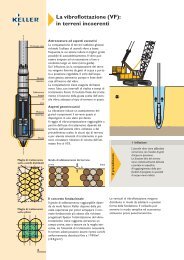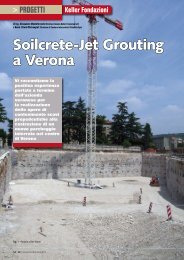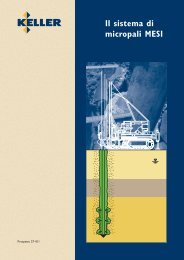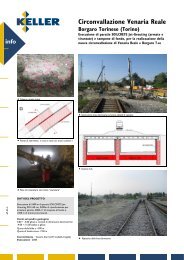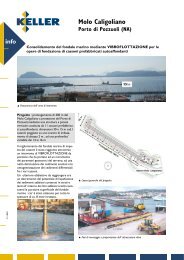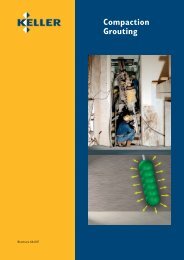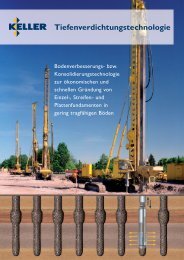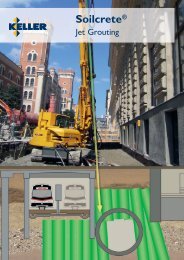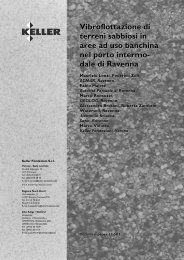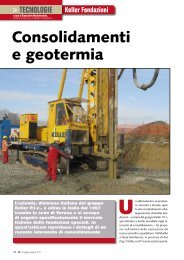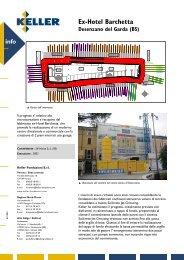Deep Soil Mixing - Keller Fondazioni SrL
Deep Soil Mixing - Keller Fondazioni SrL
Deep Soil Mixing - Keller Fondazioni SrL
Create successful ePaper yourself
Turn your PDF publications into a flip-book with our unique Google optimized e-Paper software.
<strong>Deep</strong> <strong>Soil</strong> <strong>Mixing</strong> (DSM)<br />
Improvement of weak soils<br />
by the DSM method<br />
Brochure 32-01 E
Contents<br />
<strong>Deep</strong> <strong>Soil</strong> <strong>Mixing</strong>.................. 3<br />
The Wet Method................. 4<br />
The Dry Method.................. 6<br />
Mass Stabilisation................. 7<br />
<strong>Keller</strong> Branches.................... 8
<strong>Deep</strong> <strong>Soil</strong> <strong>Mixing</strong><br />
Examples<br />
The <strong>Deep</strong> <strong>Soil</strong> <strong>Mixing</strong> method (DSM),<br />
further developed by <strong>Keller</strong>, was invented<br />
in Japan and Scandinavia. Its use is growing<br />
across the world in strengthening and sealing<br />
weak and permeable ground. The method<br />
helps to achieve significant improvement of<br />
mechanical and physical properties of the<br />
existing soil, which after mixing with cement<br />
or compound binders becomes the so-called<br />
soil-mix (or soil-cement). The stabilised<br />
soil material that is produced generally has<br />
a higher strength, lower permeability and<br />
lower compressibility than the native soil.<br />
Although the DSM technology is based on<br />
simple principles it requires, on the one<br />
hand, having significant experience and<br />
expertise in associated planning stages,<br />
involving soil-mix and geotechnical design,<br />
and execution. On the other hand it<br />
also requires the use of specialised rigs<br />
and mixing tools to meet specifications<br />
imposed by ongoing quality assessments<br />
and performance monitoring procedures.<br />
Wet and Dry mixing<br />
Basically there are two different mixing<br />
methods. The existing soil which has to be<br />
improved can be mixed mechanically other<br />
with a slurry including binder (wet DSM) or<br />
with a dry binder (dry DSM). Jetting of slurry<br />
can be also used to enhance mechanical<br />
mixing.<br />
The wet method is more appropriate in<br />
soft clays, silts and fine-grained sands with<br />
lower water content and in stratified ground<br />
conditions including interbedded soft and<br />
stiff or dense soil layers. The dry method<br />
is more suitable for soft soils with very high<br />
moisture content, and hence appropriate<br />
for mixing with dry binders. Stabilisation of<br />
organic soils and sludges is also possible,<br />
but is more difficult and requires carefully<br />
tailored binders and execution procedures.<br />
Advantages of Technology<br />
DSM technology is based on a stimulating<br />
concept of improving natural soils or<br />
brownfield ground to match adopted design<br />
requirements, so eliminating problematic<br />
excavation and replacement or more<br />
expensive deep foundation methods. Wide<br />
application range and variable patterns of<br />
execution of soil mixing columns allow for<br />
obtaining safe and very economic ground<br />
engineering solutions. The use of non-toxic<br />
binders as soil additives, including industrial<br />
by-products, as well as reduced spoil volumes<br />
comparing with jet grouting or classical drilled<br />
piles, for example, allow to position DSM<br />
as an environmentally friendly technology.<br />
The execution practice and quality control<br />
of DSM works follow European standard<br />
EN 14679.<br />
Installation of a sealing wall<br />
in a German dike<br />
Building pit wall in Austria<br />
Key benefits<br />
• economical<br />
• vibration free<br />
• flexible in application<br />
• reduces construction time<br />
• environmentally friendly<br />
Typical Applications<br />
• Embankments on soft soils<br />
• Support of strip, pad<br />
and slab foundations<br />
• Bridge and wind turbine<br />
foundations<br />
• Excavation protection walls<br />
using reinforced columns<br />
Protection of deep excavation<br />
in Poland<br />
•<br />
•<br />
•<br />
•<br />
Slope stabilisation<br />
Mitigation of liquefaction<br />
potential<br />
Cut-off walls and barriers<br />
Environmental stabilisation<br />
and solidification<br />
<strong>Deep</strong> <strong>Soil</strong> <strong>Mixing</strong> in reclaimed<br />
area in Singapore<br />
3
The wet DSM method<br />
Mechanical wet deep soil mixing<br />
Installation of DSM column<br />
In <strong>Keller</strong>’s deep soil mixing method a special<br />
mixing tool is inserted into the soil on site.<br />
This mixing tool comprises a drilling rod,<br />
transverse beams and a drill end with a<br />
head. The drilling causes no vibrations, and<br />
is assisted by cement slurry outflow from<br />
nozzles purposely located at the end of the<br />
soil auger. Once the depth specified by the<br />
design is reached, the construction phase<br />
of DSM columns commences. Basically the<br />
diameter of such columns may vary from 40<br />
to 240 cm, depending on application.<br />
The mixing tool, which may also move<br />
up and down along the column length to<br />
improve homogeneity of soil-mix, assures<br />
throughout mixing of the slurry with the soil.<br />
The composition and volume of injected<br />
slurry is adapted to the required properties<br />
of stabilised soil, taking into account the<br />
required strength and/or sealing functions.<br />
Tightness may be further enhanced by adding<br />
various components to the slurry, such as<br />
bentonite. Bending capacity of DSM elements<br />
can be increased with steel reinforcement<br />
inserted into fresh columns.<br />
Wet DSM is also possible inside a tube. This<br />
method, called Tubular <strong>Soil</strong> <strong>Mixing</strong> (TSM),<br />
is mainly used for execution of high-quality<br />
columns applied for excavation control.<br />
Operator’s cabin<br />
Ejection of slurry<br />
DSM-rig with<br />
triple mixing tool<br />
Slurry<br />
1 2 3<br />
Slurry nozzles can be<br />
located at the main rod<br />
or along mixing blades<br />
4<br />
Slurry can be injected during the penetration and withdrawal phases,<br />
with an intensity depending on soil conditions<br />
The process
Typical mixing tools used<br />
for wet DSM method<br />
Quality Control<br />
QC and QA is obtained from the installation<br />
records of the columns and from the<br />
results of appropriate laboratory and field<br />
verification tests. Each column is provided<br />
with a chart-log, which comprises: date and<br />
time of execution, length of column shaft,<br />
penetration/withdrawal rates of the mixing<br />
tool, mixing speed, pressure and flow rate<br />
of pumped slurry, total slurry consumption<br />
per column. Specimen of stabilised soils<br />
for testing are usually obtained from fresh<br />
columns with the wet grab method. Advanced<br />
core drilling and other field testing methods<br />
can be also used to obtain specimens<br />
and to inspect continuity, uniformity and<br />
stiffness of DSM columns. The selection of<br />
suitable verification methods depends on<br />
their relevance, accuracy and applicability in<br />
relation to the purpose and pattern of soil<br />
treatment and strength of stabilised soil.<br />
Design<br />
Planning of soil mixing involves assessment<br />
and selection of engineering properties of<br />
stabilised soil in specific ground conditions<br />
(soil-mix design) and selection of the<br />
installation pattern and dimensions of<br />
improved ground (geotechnical design). The<br />
expected compressive strength of stabilised<br />
soil is usually selected in relation to physical<br />
and chemical characteristics of treated soil<br />
and groundwater, type and amount of cement<br />
and other relevant working specifications, such<br />
as water/cement ratio and applied mixing<br />
work. The purpose of geotechnical design<br />
is to determine the final installation pattern<br />
and dimensions of improved ground on the<br />
basis of appropriate stability and settlement<br />
analyses to satisfy functional requirements of<br />
the supported structure. The GeTec software<br />
GRETA is often used for this purpose.<br />
Exposed DSM columns<br />
Block Grid Wall<br />
Examples of DSM column patterns<br />
Single<br />
columns<br />
Exposed cut-off wall with secant DSM columns<br />
Exposed DSM columns for a bridge support<br />
5
The dry DSM method<br />
Mechanical dry deep soil mixing<br />
Contrary to the wet method, dry soil<br />
mixing is only possible in soils that have<br />
sufficient moisture content to allow chemical<br />
reaction of stabilising binders injected in<br />
dry form with the soil and groundwater.<br />
The basic advantages of dry mixing is that<br />
stabilisation effects can be obtained in<br />
deep deposits of very weak soils, including<br />
organic ones, with high productivity, almost<br />
no spoil and cost effective. Also operations<br />
at low temperatures are possible.<br />
Typical equipment for dry DSM comprises<br />
stationary or mobile binder storage and<br />
feeding plant and a purposely designed drilling<br />
rig for installation of the columns, equipped<br />
with special mixing tool at the end of the<br />
mixing rod.<br />
Typical column diameter is 60 to 80 cm,<br />
and the depth of treatment is up to 25 m.<br />
Charging and mixing of dry binder with soil<br />
takes place while the rod is withdrawn, with<br />
mixing tool rotation direction reversed to<br />
the penetration phase direction. The binder<br />
is transported from the shuttle to the rig<br />
through connecting hoses using compressed<br />
air. Binder quantity is adjusted by changing<br />
the rotation speed of the feeding wheel.<br />
Air pressure and the amount of binder<br />
are automatically controlled to supply the<br />
specified dosage of binder to the treated<br />
zone of soil. As a rule plastic clays and<br />
silts are strengthened by lime or cement<br />
with lime, while in organic soils mixes<br />
containing blast furnace slag are used.<br />
<strong>Keller</strong> (LCM, Sweden) rig<br />
for Dry <strong>Soil</strong> <strong>Mixing</strong><br />
Ejection of dry binder from<br />
the mixing tool<br />
<strong>Keller</strong>-Shuttle type 1010<br />
for Dry <strong>Soil</strong> <strong>Mixing</strong><br />
Rigs and shuttles<br />
in operation<br />
Binder<br />
1 2 3<br />
4<br />
The process<br />
6
A selection of dry mixing tools<br />
used for different soils<br />
Quality Control<br />
Similarly as for DSM columns constructed<br />
with the wet method, quality assessments<br />
and performance monitoring methods<br />
are conducted both during execution and<br />
after completion of works. Each column<br />
is provided with a chart-log printed by<br />
an automatic recording device. Upon<br />
completion of works control tests are<br />
carried out pursuant to assumptions<br />
adopted in the design. Standard tests involve<br />
mainly probe testing, which are feasible in<br />
columns designed for lower strength, and<br />
include Modified Cone Penetration Tests<br />
and Pull Out Resistance Tests to avoid the<br />
problem of the cone’s tendency to steer<br />
out of longer columns. Also laboratory<br />
tests on specimens extracted from exposed<br />
columns can be carried out, if required.<br />
Record of production<br />
Depth<br />
Pull Out<br />
Resistance<br />
Test (PORT)<br />
Modified Cone<br />
Penetration<br />
Test (MCPT)<br />
Shear strength<br />
DSM field tests for quality control<br />
Mass Stabilisation for shallow mixing<br />
Shallow dry mixing offers a cost-effective<br />
solution for ground improvement works or<br />
site remediation when dealing with substantial<br />
volumes of very weak or contaminated<br />
superficial soils with high water content,<br />
such as deposits of dredged sediments, wet<br />
organic soils or waste sludges. In this method<br />
special mixing tools are used, which are in<br />
most cases fixed to an excavator’s rig arm.<br />
<strong>Mixing</strong> is executed vertically or horizontally,<br />
with mixing tools that resemble screw<br />
propellers having a centrally provided nozzle<br />
for binder. The binder is fed from a separate<br />
unit which houses the pressurised binder<br />
container, compressor, air dryer and supply<br />
control unit.<br />
Stabilisation is executed in phases, according<br />
to the operational range of the drilling rig,<br />
which generally comprises an area of 8 to<br />
10 m² and depth up to approx. 4 m. Once<br />
the required binder volume has been applied,<br />
mixing is continued to assure the optimum<br />
mixing properties.<br />
Examples of mixing tools<br />
for mass stabilisation<br />
weak<br />
soil<br />
improved soil<br />
weak<br />
soil<br />
improved soil<br />
7
www.<strong>Keller</strong>Grundbau.com<br />
www.<strong>Keller</strong>Holding.com<br />
www.kellerfareast.com<br />
www.<strong>Keller</strong>Grundbau.ae<br />
A company of <strong>Keller</strong> Group plc



